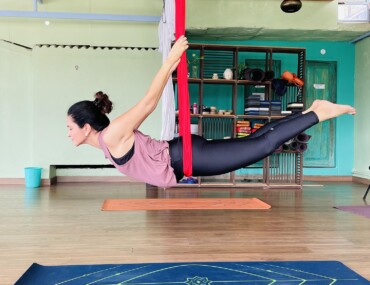Do you also fantasize about Aerial yoga? Are you also fear performing Aerial yoga? If your answers are YES, read more.
Here we bring you a blog that will eradicate your fear of aerial yoga and finally light a deep desire to learn Aerial Yoga.
Aerial yoga uses a hammock as a prop of yoga. A hammock is a tool for all levels and styles of yoga. It is a tool to bring balance, refining your postures, assisting in alignment, deepening the stretches, and safely inverting without compressing the spine.
The blog will take you to excellent five Aerial yoga exercises that are a treat to your body. These poses will reduce your pain, overcome fear, and build your confidence and strength. Also, you will be amazed to know the magic of Floating Shavasana.
Must Learn Five Aerial Yoga Poses
1. Half-Boat Pose
This yoga posture is named after the shape it takes that is of a boat. The pose is like a full-body workout and aids you in several ways. One should not perform the pose if one suffers from low blood pressure, severe headaches, or migraines.
How to do It
- Place your sacrum on the bottom of the U-shape in the hammock.
- Now lean back against the hammock and engage your abdominal muscles to lift the legs.
- At the same time, use your strong arms to prevent the hammock from sliding up the back and swinging.
- Bend your knees to help transfer your weight from the floor to the hammock.
- Then slide your hands farther up the sides and straighten your knees, bringing your legs apart to help balance.
- Adjust the fabric if it slips off the sacrum.
- Hold the position for five deep breaths.
Benefits
- It tones and strengthens the abdominal muscles.
- It improves balance and digestion.
- It stimulates the kidney, thyroid, and intestines.
- It aids in relieving stress.
- Also, it enhances your confidence and stamina.
2. Plank With Hammock
Doing a hammock plank is far superior to using the traditional plank method. Using a hammock for a plank will bring great control and awareness to your body. The position forces the body to recruit more muscle fiber than is needed on a stable non-moving surface.
How to do It
- Place both your forearms and feet on the floor while balancing your body.
- When using a hammock, elevate your legs on the swing and hold to the same position.
- Hold in this position for about 20-40sec, squeezing in your abs.
- The position will engage more in your glutes since the hammock is higher than your hands.
Benefits
- It strengthens and tones the core, shoulders, spine, and legs.
- It treats your lower back pain effectively.
- Plank with Hammock brings stability and balance to your life.
- It improves posture and confidence too.
3. Star Inversion
It is an anti-gravity Yoga pose that is more creative and challenging. It is difficult since the hands and kegs are not bound with a hammock. It is a beneficial practice to align the spine naturally.
How to do It
- Stand in a mountain pose with a hammock behind you.
- Pull the hammock holding it close to your hips, and place it against your sacrum to rest against your back hips and lower back.
- Now move the hands to the sides while the thumbs are locked.
- Next is to let go of your hand from the floor and hang in inversion till the body feels stable.
- Control your breath and the movement, and your body is in star inversion.
Benefits
- It strengthens the heels and balls of the feet.
- Improves the alignment of the body.
- It improves the balance of the body.
- It relaxes your mind and helps you to think more clearly.
- It relieves menstrual pain and menopause symptoms.
4. Inverted Pigeon Pose
If you plan to do something adventurous with Aerial yoga, you must give a try to Pigeon pose. The pose gives you a deep stretch on your hips and helps you to re-align your spine. It benefits people who are at a desk for a longer time.
How to do It
- Stand before the sling, and place the sling at the sacrum.
- Now inhale, lift your feet off the floor, and kneed up and wide.
- Exhale slowing while bringing legs up.
- Hook feet into the sling.
- Next is to draw the right foot down sling.
- Allow the right foot to hook at the face of the left side of the pigeon pose.
- You can also stretch further to hip joints and legs.
- Allow your left foot to fall behind youtube and land into the inverted pigeon pose.
- If comfortable, reach to the back foot and hold the pose.
Benefits
- It helps to open up your hips, making the joint mobile and flexible.
- It helps in easing the digestion process.
- Also, it helps in removing any lower back pain.
- The inverted Pigeon pose increases your blood circulation.
5. Floating Shavasana
Shavasana, also known as the Corpse pose, is an intermediate-level yoga involving strength, stretch, and balance. The posture makes ease, sinking and melting, taking you to a deeply relaxed state.
How to do It
- Stand in front of the fabric and gather the material with both hands from the bottom.
- Now turn your back away from the fabric with the cloth still gathered in your hand.
- Sit and slide in the collected material, and stretch the gathered fabric out and under you.
- As you lay in Shavasana, let your entire body completely melt into the fabric.
- Keep your feets snug inside a Hammock to feel safe and grounded.
- Also, snug your arms next to you or cross over the chest.
Benefits
- It helps you to surrender yourself, making you feel light.
- It calms your mind and relaxes your body.
- While doing Shavasana, using a hammock makes you feel safe and secure.
- Reset and Renew with the Shavasana Pose.
Wrapping Up
If you have always wanted to do Aerial yoga, now is the time. Learn Aerial yoga and make your body flexible, stable, and powerful. Aerial yoga is a fantastic form of yoga that ditch the dullness of yoga by revamping with a hammock.
Learn under the guidance of professionals, and you will fall in love with Aerial yoga. It is unique, phenomenal, and everything you ever thought of.
Frequently Asked Questions
1. Is Aerial Yoga Safe?
Every sport carries risk, and so is with Aerial yoga. One can minimize the risk by taking safety measures seriously. Always practice aerial yoga professionally and with all the necessary equipment designed for safety.
2. I have a health condition. Can I try Aerial Yoga?
You should consult your doctor before joining any workout if you suffer from severe health conditions. Exercise with extreme caution if you have osteoporosis, glaucoma, high blood pressure, low blood pressure, or any neurological disorders.
3. Can heavy people use Hammock?
You would be glad to know that a hammock does not fat shame people; thus, it is for everyone. Most apparatus and equipment used for aerial yoga are tested with a maximum weight of 330lbs (150kg).
4. How Do I learn Aerial Yoga?
The best way to learn Aerial yoga is to join an Aerial Yoga School. These schools are effective and provide elaborative support with equipment and guidance. You can also look for local Aerial classes near you to learn quickly.




